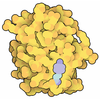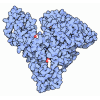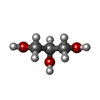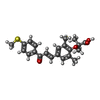[English] 日本語
 Yorodumi
Yorodumi- PDB-8huq: X-ray structure of human PPAR alpha ligand binding domain-elafibr... -
+ Open data
Open data
- Basic information
Basic information
| Entry | Database: PDB / ID: 8huq | ||||||||||||
|---|---|---|---|---|---|---|---|---|---|---|---|---|---|
| Title | X-ray structure of human PPAR alpha ligand binding domain-elafibranor-SRC1 coactivator peptide co-crystals obtained by soaking | ||||||||||||
 Components Components |
| ||||||||||||
 Keywords Keywords | TRANSCRIPTION / Nuclear receptor / Protein-ligand complex / PPAR | ||||||||||||
| Function / homology |  Function and homology information Function and homology informationpositive regulation of transformation of host cell by virus / regulation of fatty acid transport / enamel mineralization / positive regulation of fatty acid beta-oxidation / cellular response to fructose stimulus / regulation of ketone metabolic process / regulation of fatty acid metabolic process / negative regulation of cell growth involved in cardiac muscle cell development / negative regulation of appetite / negative regulation of hepatocyte apoptotic process ...positive regulation of transformation of host cell by virus / regulation of fatty acid transport / enamel mineralization / positive regulation of fatty acid beta-oxidation / cellular response to fructose stimulus / regulation of ketone metabolic process / regulation of fatty acid metabolic process / negative regulation of cell growth involved in cardiac muscle cell development / negative regulation of appetite / negative regulation of hepatocyte apoptotic process / lipoprotein metabolic process / positive regulation of fatty acid oxidation / behavioral response to nicotine / negative regulation of leukocyte cell-cell adhesion / labyrinthine layer morphogenesis / positive regulation of transcription from RNA polymerase II promoter by galactose / regulation of thyroid hormone receptor signaling pathway / positive regulation of female receptivity / negative regulation of glycolytic process / ubiquitin conjugating enzyme binding / mitogen-activated protein kinase kinase kinase binding / positive regulation of fatty acid metabolic process / NR1H2 & NR1H3 regulate gene expression to control bile acid homeostasis / male mating behavior / DNA-binding transcription activator activity / NFAT protein binding / negative regulation of cholesterol storage / hypothalamus development / positive regulation of ATP biosynthetic process / nuclear steroid receptor activity / cellular response to Thyroglobulin triiodothyronine / negative regulation of macrophage derived foam cell differentiation / Synthesis of bile acids and bile salts / progesterone receptor signaling pathway / epidermis development / Synthesis of bile acids and bile salts via 27-hydroxycholesterol / Endogenous sterols / Synthesis of bile acids and bile salts via 7alpha-hydroxycholesterol / response to retinoic acid / nuclear retinoid X receptor binding / phosphatase binding / estrous cycle / positive regulation of lipid biosynthetic process / Transcriptional regulation of brown and beige adipocyte differentiation by EBF2 / histone acetyltransferase activity / cellular response to hormone stimulus / Recycling of bile acids and salts / histone acetyltransferase / intracellular receptor signaling pathway / negative regulation of blood pressure / NR1H3 & NR1H2 regulate gene expression linked to cholesterol transport and efflux / nitric oxide metabolic process / hormone-mediated signaling pathway / estrogen receptor signaling pathway / positive regulation of adipose tissue development / negative regulation of reactive oxygen species biosynthetic process / : / lactation / Regulation of lipid metabolism by PPARalpha / response to nutrient / peroxisome proliferator activated receptor signaling pathway / MDM2/MDM4 family protein binding / regulation of cellular response to insulin stimulus / positive regulation of gluconeogenesis / positive regulation of neuron differentiation / negative regulation of cytokine production involved in inflammatory response / negative regulation of phosphatidylinositol 3-kinase/protein kinase B signal transduction / BMAL1:CLOCK,NPAS2 activates circadian expression / negative regulation of miRNA transcription / SUMOylation of transcription cofactors / Activation of gene expression by SREBF (SREBP) / response to progesterone / cerebellum development / cellular response to starvation / nuclear estrogen receptor binding / nuclear receptor binding / gluconeogenesis / hippocampus development / RNA polymerase II transcription regulatory region sequence-specific DNA binding / SUMOylation of intracellular receptors / negative regulation of transforming growth factor beta receptor signaling pathway / mRNA transcription by RNA polymerase II / circadian regulation of gene expression / fatty acid metabolic process / wound healing / Heme signaling / Transcriptional activation of mitochondrial biogenesis / PPARA activates gene expression / regulation of circadian rhythm / response to insulin / Cytoprotection by HMOX1 / cerebral cortex development / Transcriptional regulation of white adipocyte differentiation / Nuclear Receptor transcription pathway / negative regulation of inflammatory response / DNA-binding transcription repressor activity, RNA polymerase II-specific / RNA polymerase II transcription regulator complex / transcription coactivator binding / male gonad development / nuclear receptor activity Similarity search - Function | ||||||||||||
| Biological species |  Homo sapiens (human) Homo sapiens (human) | ||||||||||||
| Method |  X-RAY DIFFRACTION / X-RAY DIFFRACTION /  SYNCHROTRON / SYNCHROTRON /  MOLECULAR REPLACEMENT / MOLECULAR REPLACEMENT /  molecular replacement / Resolution: 1.65 Å molecular replacement / Resolution: 1.65 Å | ||||||||||||
 Authors Authors | Kamata, S. / Ishikawa, R. / Akahane, M. / Honda, A. / Oyama, T. / Ishii, I. | ||||||||||||
| Funding support |  Japan, 3items Japan, 3items
| ||||||||||||
 Citation Citation |  Journal: Antioxidants / Year: 2023 Journal: Antioxidants / Year: 2023Title: Functional and Structural Insights into the Human PPAR alpha / delta / gamma Targeting Preferences of Anti-NASH Investigational Drugs, Lanifibranor, Seladelpar, and Elafibranor. Authors: Kamata, S. / Honda, A. / Ishikawa, R. / Akahane, M. / Fujita, A. / Kaneko, C. / Miyawaki, S. / Habu, Y. / Shiiyama, Y. / Uchii, K. / Machida, Y. / Oyama, T. / Ishii, I. | ||||||||||||
| History |
|
- Structure visualization
Structure visualization
| Structure viewer | Molecule:  Molmil Molmil Jmol/JSmol Jmol/JSmol |
|---|
- Downloads & links
Downloads & links
- Download
Download
| PDBx/mmCIF format |  8huq.cif.gz 8huq.cif.gz | 74.6 KB | Display |  PDBx/mmCIF format PDBx/mmCIF format |
|---|---|---|---|---|
| PDB format |  pdb8huq.ent.gz pdb8huq.ent.gz | 52.3 KB | Display |  PDB format PDB format |
| PDBx/mmJSON format |  8huq.json.gz 8huq.json.gz | Tree view |  PDBx/mmJSON format PDBx/mmJSON format | |
| Others |  Other downloads Other downloads |
-Validation report
| Summary document |  8huq_validation.pdf.gz 8huq_validation.pdf.gz | 711 KB | Display |  wwPDB validaton report wwPDB validaton report |
|---|---|---|---|---|
| Full document |  8huq_full_validation.pdf.gz 8huq_full_validation.pdf.gz | 714.8 KB | Display | |
| Data in XML |  8huq_validation.xml.gz 8huq_validation.xml.gz | 13.5 KB | Display | |
| Data in CIF |  8huq_validation.cif.gz 8huq_validation.cif.gz | 18.2 KB | Display | |
| Arichive directory |  https://data.pdbj.org/pub/pdb/validation_reports/hu/8huq https://data.pdbj.org/pub/pdb/validation_reports/hu/8huq ftp://data.pdbj.org/pub/pdb/validation_reports/hu/8huq ftp://data.pdbj.org/pub/pdb/validation_reports/hu/8huq | HTTPS FTP |
-Related structure data
| Related structure data |  8hukC 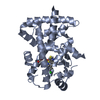 8hulC  8humC  8hunC  8huoC  8hupC  7bq1S S: Starting model for refinement C: citing same article ( |
|---|---|
| Similar structure data | Similarity search - Function & homology  F&H Search F&H Search |
- Links
Links
- Assembly
Assembly
| Deposited unit | 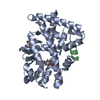
| ||||||||
|---|---|---|---|---|---|---|---|---|---|
| 1 |
| ||||||||
| Unit cell |
|
- Components
Components
| #1: Protein | Mass: 30856.053 Da / Num. of mol.: 1 Source method: isolated from a genetically manipulated source Source: (gene. exp.)  Homo sapiens (human) / Plasmid: pet28a / Production host: Homo sapiens (human) / Plasmid: pet28a / Production host:  |
|---|---|
| #2: Protein/peptide | Mass: 1848.177 Da / Num. of mol.: 1 / Source method: obtained synthetically / Source: (synth.)  Homo sapiens (human) / References: UniProt: Q15788, histone acetyltransferase Homo sapiens (human) / References: UniProt: Q15788, histone acetyltransferase |
| #3: Chemical | ChemComp-GOL / |
| #4: Chemical | ChemComp-MUO / |
| #5: Water | ChemComp-HOH / |
| Has ligand of interest | Y |
-Experimental details
-Experiment
| Experiment | Method:  X-RAY DIFFRACTION / Number of used crystals: 1 X-RAY DIFFRACTION / Number of used crystals: 1 |
|---|
- Sample preparation
Sample preparation
| Crystal | Density Matthews: 2.15 Å3/Da / Density % sol: 42.91 % |
|---|---|
| Crystal grow | Temperature: 277 K / Method: vapor diffusion / Details: 0.1 M Tris (pH 8.5), 25%(w/v) PEG3350 |
-Data collection
| Diffraction | Mean temperature: 100 K / Serial crystal experiment: N | |||||||||||||||||||||||||||
|---|---|---|---|---|---|---|---|---|---|---|---|---|---|---|---|---|---|---|---|---|---|---|---|---|---|---|---|---|
| Diffraction source | Source:  SYNCHROTRON / Site: SYNCHROTRON / Site:  Photon Factory Photon Factory  / Beamline: BL-17A / Wavelength: 1 Å / Beamline: BL-17A / Wavelength: 1 Å | |||||||||||||||||||||||||||
| Detector | Type: DECTRIS EIGER X 16M / Detector: PIXEL / Date: Dec 12, 2020 / Details: Mirrors | |||||||||||||||||||||||||||
| Radiation | Monochromator: Si(111) / Protocol: SINGLE WAVELENGTH / Monochromatic (M) / Laue (L): M / Scattering type: x-ray | |||||||||||||||||||||||||||
| Radiation wavelength | Wavelength: 1 Å / Relative weight: 1 | |||||||||||||||||||||||||||
| Reflection | Resolution: 1.65→42.9 Å / Num. obs: 31932 / % possible obs: 95.5 % / Redundancy: 3.5 % / Biso Wilson estimate: 25.87 Å2 / CC1/2: 1 / Rmerge(I) obs: 0.022 / Rpim(I) all: 0.014 / Rrim(I) all: 0.026 / Net I/σ(I): 17.6 / Num. measured all: 111877 / Scaling rejects: 1 | |||||||||||||||||||||||||||
| Reflection shell | Diffraction-ID: 1
|
-Phasing
| Phasing | Method:  molecular replacement molecular replacement | |||||||||
|---|---|---|---|---|---|---|---|---|---|---|
| Phasing MR |
|
- Processing
Processing
| Software |
| ||||||||||||||||||||||||||||||||||||||||||||||||||||||||||||||||||||||||||||||||||||||||||||||||||||||||||||||||||||||||||||||||||||||||||
|---|---|---|---|---|---|---|---|---|---|---|---|---|---|---|---|---|---|---|---|---|---|---|---|---|---|---|---|---|---|---|---|---|---|---|---|---|---|---|---|---|---|---|---|---|---|---|---|---|---|---|---|---|---|---|---|---|---|---|---|---|---|---|---|---|---|---|---|---|---|---|---|---|---|---|---|---|---|---|---|---|---|---|---|---|---|---|---|---|---|---|---|---|---|---|---|---|---|---|---|---|---|---|---|---|---|---|---|---|---|---|---|---|---|---|---|---|---|---|---|---|---|---|---|---|---|---|---|---|---|---|---|---|---|---|---|---|---|---|---|
| Refinement | Method to determine structure:  MOLECULAR REPLACEMENT MOLECULAR REPLACEMENTStarting model: 7BQ1 Resolution: 1.65→32.799 Å / SU ML: 0.21 / Cross valid method: FREE R-VALUE / σ(F): 1.94 / Phase error: 23.24 / Stereochemistry target values: ML
| ||||||||||||||||||||||||||||||||||||||||||||||||||||||||||||||||||||||||||||||||||||||||||||||||||||||||||||||||||||||||||||||||||||||||||
| Solvent computation | Shrinkage radii: 0.9 Å / VDW probe radii: 1.11 Å / Solvent model: FLAT BULK SOLVENT MODEL | ||||||||||||||||||||||||||||||||||||||||||||||||||||||||||||||||||||||||||||||||||||||||||||||||||||||||||||||||||||||||||||||||||||||||||
| Displacement parameters | Biso max: 95.94 Å2 / Biso mean: 34.4439 Å2 / Biso min: 14.77 Å2 | ||||||||||||||||||||||||||||||||||||||||||||||||||||||||||||||||||||||||||||||||||||||||||||||||||||||||||||||||||||||||||||||||||||||||||
| Refinement step | Cycle: final / Resolution: 1.65→32.799 Å
| ||||||||||||||||||||||||||||||||||||||||||||||||||||||||||||||||||||||||||||||||||||||||||||||||||||||||||||||||||||||||||||||||||||||||||
| Refine LS restraints |
| ||||||||||||||||||||||||||||||||||||||||||||||||||||||||||||||||||||||||||||||||||||||||||||||||||||||||||||||||||||||||||||||||||||||||||
| LS refinement shell | Refine-ID: X-RAY DIFFRACTION / Rfactor Rfree error: 0
|
 Movie
Movie Controller
Controller


 PDBj
PDBj



